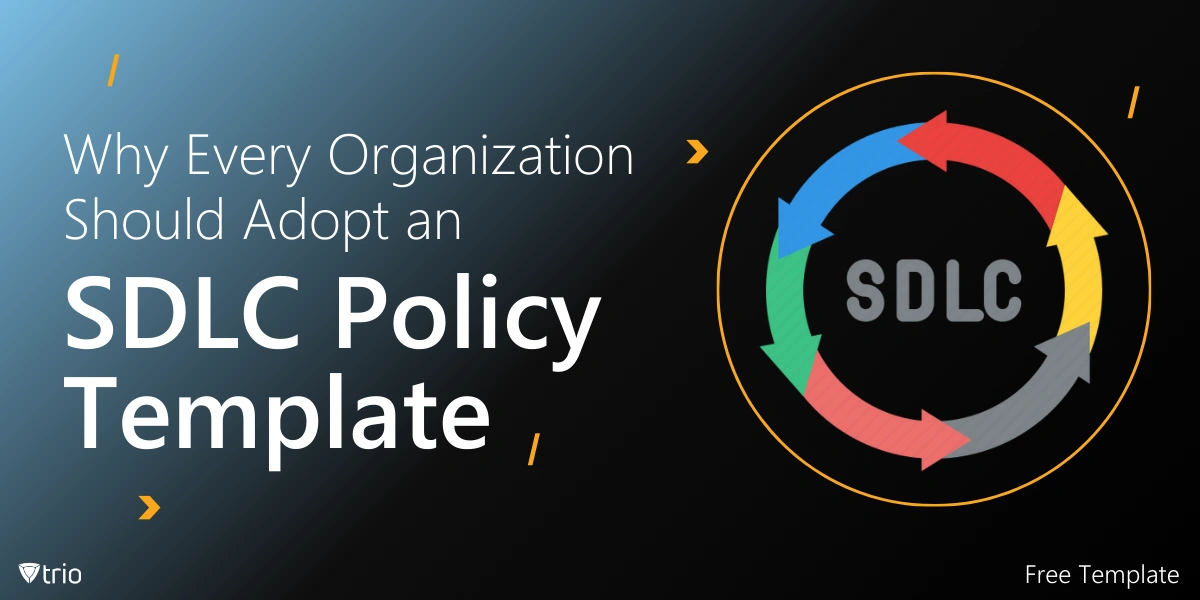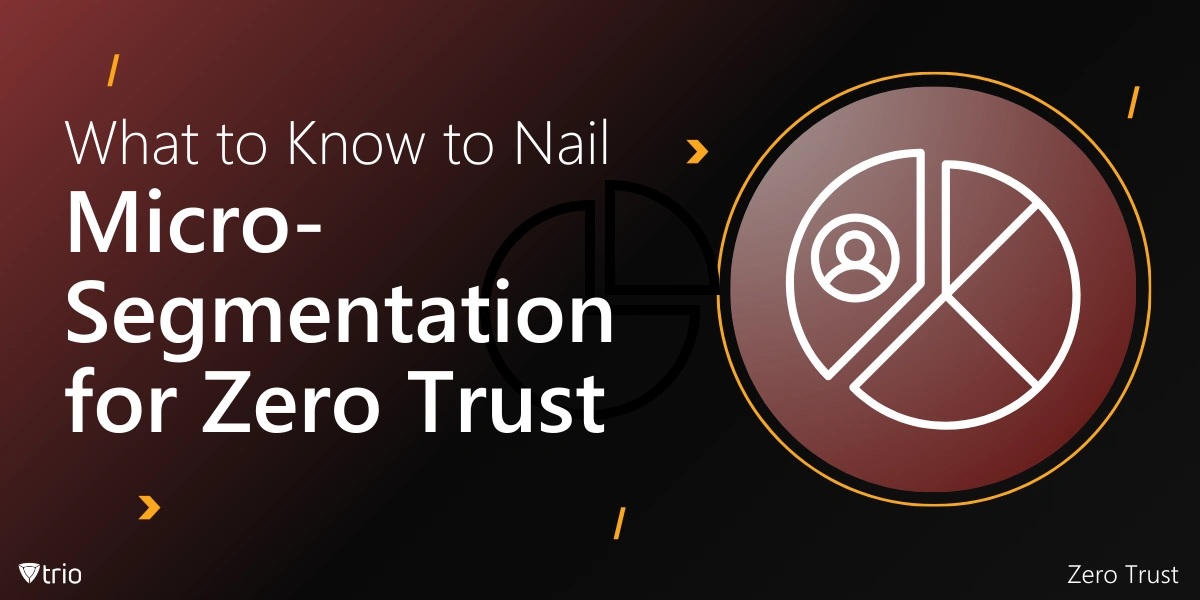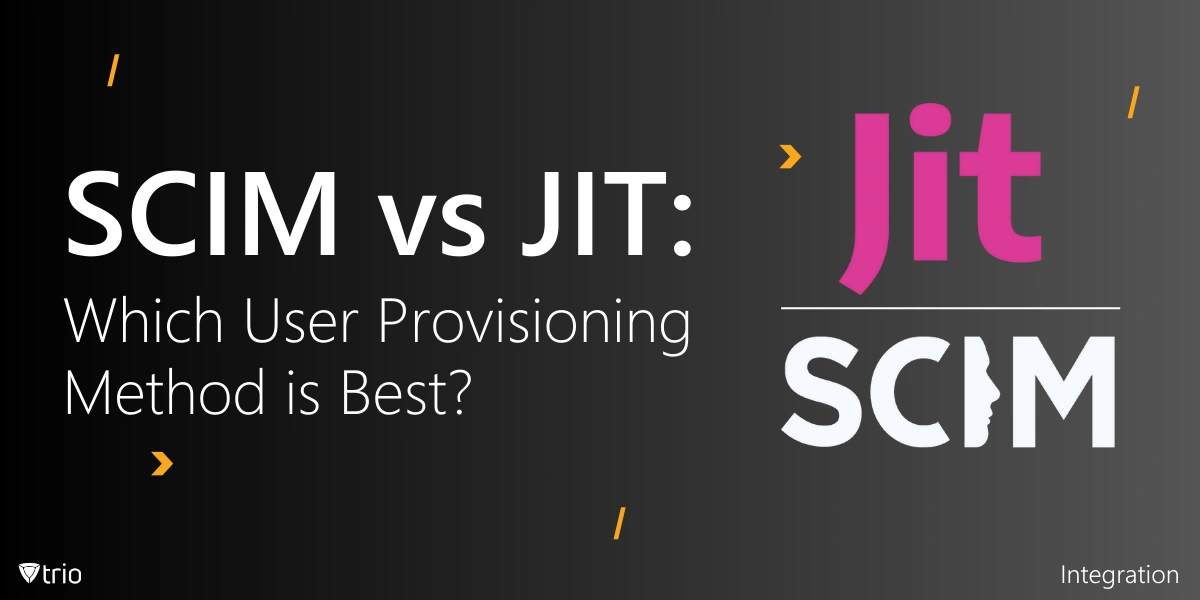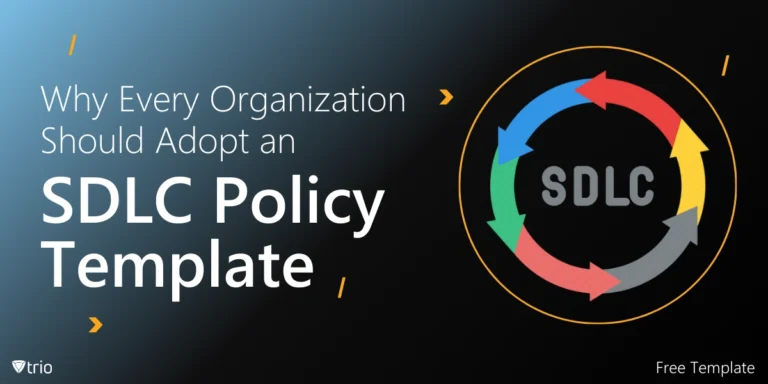Managing software development efficiently and securely requires a standardized framework. The SDLC Policy Template is designed to help IT teams implement consistent, high-quality processes that align with regulatory standards, prioritize security, and ensure project success. This blog explains the purpose, scope, objectives, and critical components of the template, helping organizations improve their software development life cycle management.
What is the SDLC Policy Template?
The SDLC Policy Template outlines a standardized policy for managing the software development life cycle (SDLC) within an organization. It provides a structured framework to align software development processes with industry best practices, maintain compliance with regulatory standards, and prioritize quality, security, and efficiency. By defining roles, responsibilities, and phases, the template aims to reduce project risks, enhance collaboration, and ensure successful software delivery.
Why Does Your Organization Need an SDLC Policy?
Every organization might need an SDLC policy for a different reason. Understanding the purpose and the role of the policy can help to make the final decision.
The Purpose of an SDLC Policy
The primary purpose of a software development life cycle (SDLC) policy is to ensure that all software development activities are conducted in a consistent, secure, and efficient manner. A standardized policy fosters alignment with organizational goals, helping teams deliver high-quality software while reducing risks and maintaining compliance with industry and regulatory requirements.
By providing a clear roadmap for software development, the policy promotes process transparency, enforces accountability, and protects sensitive data against vulnerabilities. It helps organizations meet stringent compliance requirements, such as ISO 27001 or GDPR, ensuring long-term trust and credibility with stakeholders.
The Role of the Policy in Risk Mitigation and Quality Assurance
With the increasing complexity of software systems, minimizing risks is critical. The SDLC Policy Template supports this by implementing quality checks and security measures at every phase of the development process. From planning and design to deployment and maintenance, the policy ensures that software is not only functional but also secure, scalable, and aligned with user needs.

Defining the Scope of the SDLC Policy
The SDLC Policy applies to all software development initiatives, whether they are conducted in-house, outsourced, or involve third-party vendors. It’s relevant for projects of all sizes and complexities, ensuring that every stakeholder adheres to the same set of principles and guidelines.
Key stakeholders include developers, project managers, quality assurance (QA) teams, security analysts, business analysts, and any external collaborators involved in the software lifecycle. By fostering cross-functional collaboration, the policy facilitates better communication and coordination across teams.
Applications of the Policy
The SDLC Policy Template governs all phases of the software development life cycle, including planning, coding, testing, deployment, and maintenance. It also applies to any updates, patches, or modifications to existing software. Whether your organization is building a custom application or integrating third-party software, this policy ensures compliance with industry best practices throughout.
Core Objectives of the SDLC Policy Template
Using the SDLC policy template has several objectives, including:
Standardizing the Software Development Process
The template ensures a structured and standardized approach to software development, promoting uniformity across all projects. This reduces inefficiencies, improves project timelines, and eliminates unnecessary redundancies in the development process.
Additionally, adhering to a defined SDLC policy minimizes security vulnerabilities by enforcing secure coding practices and rigorous testing protocols.
Enhancing Collaboration and Transparency
The SDLC Policy encourages teamwork by clearly defining roles, responsibilities, and procedures. By fostering transparency, the policy ensures that all stakeholders remain aligned, enabling better project management and decision-making.
Roles and Responsibilities
An effective SDLC Policy assigns clear responsibilities to stakeholders:
- Project Managers oversee project timelines, resource allocation, and milestone tracking.
- Developers write, test, and maintain code according to approved standards.
- QA Teams conduct comprehensive testing to ensure software quality.
- Security Analysts assess risks and implement security controls.
- Business Analysts gather requirements and act as liaisons between technical and business teams.
By outlining roles, the policy fosters accountability and collaboration, reducing communication gaps and ensuring seamless workflows.
Breaking Down the Software Development Life Cycle Phases
To completely understand the software development life cycle, we’ve broken down each phase.
Planning
The planning phase involves defining objectives, identifying requirements, and allocating resources. It lays the groundwork for a successful project, ensuring alignment with business goals and stakeholder expectations.
Requirements Gathering
This phase focuses on collecting and documenting functional, non-functional, and security requirements. Comprehensive requirement analysis minimizes misunderstandings and sets the stage for successful development.
Design
The design phase involves creating architectural and system designs that include security considerations. Proper design ensures scalability, maintainability, and alignment with user needs.
Development
During development, coding is performed according to predefined standards and guidelines. The policy emphasizes secure coding practices to prevent vulnerabilities.
Testing
Testing is crucial to identify and resolve bugs or vulnerabilities. It includes unit testing, integration testing, and user acceptance testing to ensure the software meets quality standards.
Deployment and Maintenance
The deployment phase involves releasing the software in a controlled manner, while the maintenance phase focuses on updates, patches, and continuous support to ensure long-term functionality and security.
Download Our Free SDLC Policy Template
Ready to implement these phases in your organization?
Download our free SDLC Policy Template to get a structured framework for managing your software development life cycle effectively and efficiently.
Ensuring Compliance and Security
Ensuring compliance and security throughout the software development life cycle is crucial for maintaining the integrity of both the software and the organization. The SDLC Policy Template emphasizes strict adherence to industry standards such as ISO 27001, GDPR, and PCI DSS, ensuring that the software complies with regulatory requirements, protects sensitive data, and upholds user trust. Security is prioritized across all phases of the development process, with the policy incorporating guidelines for secure coding practices, vulnerability assessments, and penetration testing. These measures help identify and address potential security risks early, ensuring that the software remains secure and resilient against threats.
Managing Changes with a Change Management Process
Managing changes effectively is essential for keeping software development projects on track and aligned with organizational goals. The SDLC Policy Template ensures that any changes to the project scope, requirements, or timelines are thoroughly documented and reviewed. By requiring approval from relevant stakeholders, the policy helps minimize risks associated with unapproved changes. At the same time, it maintains flexibility, allowing organizations to adapt to new information or evolving needs without compromising quality or project timelines. This balanced approach ensures that changes are carefully managed while enabling the project to remain responsive to emerging challenges.
Quality Assurance and Documentation
Quality assurance and thorough documentation are fundamental components of a successful software development process. The SDLC Policy Template emphasizes the importance of comprehensive testing, utilizing both automated tools and manual processes to ensure that the software meets performance, security, and usability standards. Multiple levels of testing, ranging from unit tests to user acceptance tests, are encouraged to ensure the software is robust and ready for deployment.
Additionally, the policy stresses the importance of centralized documentation, with all relevant materials—such as design documents, test cases, and deployment plans—stored in a central repository. This centralized approach facilitates knowledge sharing across teams and ensures that critical information is easily accessible for future reference, promoting continuity and efficiency throughout the development life cycle.
Monitoring, Review, and Continuous Improvement
Monitoring, review, and continuous improvement are key to maintaining the effectiveness of the software development process. The SDLC Policy Template incorporates processes for tracking progress through performance metrics or key performance indicators (KPIs). This allows for the timely identification of issues and opportunities for improvement, ensuring that the development process stays on course. Additionally, regular periodic reviews are essential for refining SDLC processes, helping organizations optimize workflows, improve efficiency, and better align their efforts with organizational goals. This ongoing review cycle fosters a culture of continuous improvement, ensuring that the development process remains adaptable and responsive to evolving needs.
Training and Policy Enforcement
Regular training sessions are integral to keeping employees informed about the latest tools, technologies, and best practices, fostering a culture of continuous learning. This ongoing education not only enhances skills but also improves compliance with the SDLC Policy, ensuring that teams remain up-to-date with industry standards. To further ensure adherence, the policy includes provisions for audits and periodic checks to enforce compliance. Clear consequences for non-compliance are outlined, holding teams accountable and reinforcing the importance of following the established processes to maintain quality and security throughout the software development life cycle.

How Trio Can Help with Your SDLC Policy Template
Managing an SDLC Policy effectively requires the right tools. Trio, a powerful MDM (Mobile Device Management) solution, simplifies SDLC policy management by streamlining documentation, enhancing collaboration, and ensuring compliance with regulatory standards. Trio’s centralized platform ensures that all stakeholders can access, update, and manage SDLC documentation with ease.
Discover how Trio can help your organization implement and maintain an SDLC Policy Template. Request a free demo today and revolutionize your software development processes.







